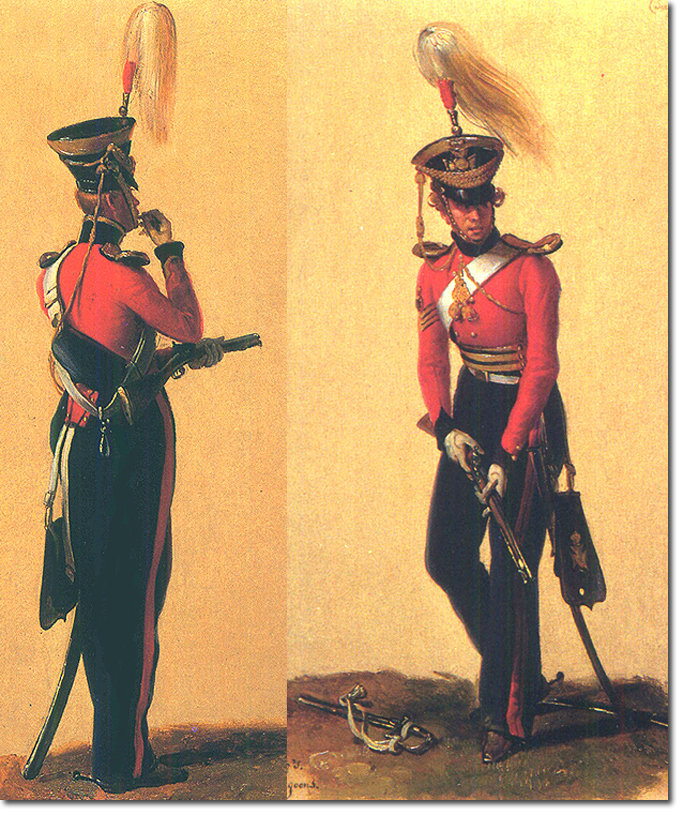|
|


|
|
This composite image is from two paintings by Dubois Drahonet, completed in 1832. The Private, on the left was Charles Corchill and the the sergeant was John Brookfield. The information on these two men and their uniforms is examined by Percy Sumner in the Journal for the Society of Army Historical Research vol XXVIII no.114 and in Portraits for a King, The British Military Paintings of A-J Dubois Drahonet by Jenny Spencer-Smith (NAM 1990). They are very valuable sources of information on the dress and equipment of light dragoons of this period, more so because the artist shows the back view as well as the front. The back view shows the short tails to the scarlet coatee. They have blue turn-backs and piping, and six buttons.
The shakos worn by both men have the elaborate plaited festoon across the front, in yellow twisted cord with flounders and tassels at the end. Sergeant Brookfield has his around his upper body but Private Corchill's disappears on his left side, probably hooked up on his shoulder. The lace around the top of the shako is yellow for privates and gold lace for the sergeants. Their plumes are white horsehair with a red base, coming out of a brass socket. The badge on the front is a Maltese cross with crown above. On their shoulders are large brass scales similar to those worn by officers in undress. The 14th LD were the first regiment to request these items, in Oct 1821, but were refused. But in Oct 1823 they were permitted for the 3rd LD, and then on 6 Feb 1824 they became regulation for all light dragoon regiments. The backing cloth is of the facings colour which, for the 14th King's Light Dragoons, was dark blue. One of the curiosities of these two paintings is that the blue collar and cuffs are different. The private has yellow tape along the top edge of his collar and cuff while the sergeant clearly does not. The other differences are the waist girdles, blue and yellow for the sergeant , and (just visible on the original painting) red and yellow for the private. Also the double red stripe down the seam of the sergeant's trousers, and a single broad red stripe on the private's trousers. The equipment is supported by white leather belts. The plain black ammunition pouch is kept on the back, and an extra belt has a swivel spring clip to hold the carbine in place. The carbine is being held by Corchill in the prime and load position. He bites the twist of paper to release the powder. Sergeant Brookfield holds his ready to fire. It is the 1773 pattern Elliott carbine. At this time the men were also issued with pistols but they were discontinued in May 1839 so that only officers, sergeant-majors and trumpeters had those small-arms while the men retained the carbine and sword as their weapons. The sword which lies broken at Brookfield's feet is the stirrup hilted 1796 pattern. Both men have black leather sabretaches suspended on two white straps from the waist-belt. The front is decorated with a Maltese cross badge. Sergeant brookfield's arm badges can be seen more clearly at Sergeant's Arm Badge 1832. |
Armed Forces | Art and Culture | Articles | Biographies | Colonies | Discussion | Glossary | Home | Library | Links | Map Room | Sources and Media | Science and Technology | Search | Student Zone | Timelines | TV & Film | Wargames